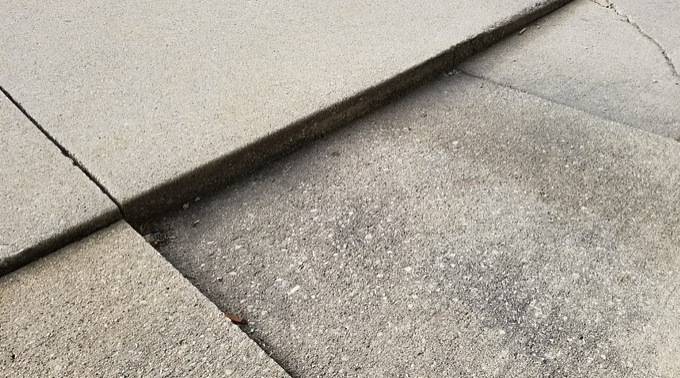10 Reasons Your Sidewalk Is Sinking
Have you noticed your concrete sidewalk is settling or sinking? Sidewalks can sink or settle for several reasons. At PolyPier, our concrete leveling experts have experience working with settling issues of all varieties.
Causes of Sidewalk Settling

- Poor soil compaction: If the soil beneath the concrete sidewalk is not adequately compacted during construction, it can compress over time, leading to sinking or settling.
- Soil erosion: Water runoff or poor drainage can wash away soil beneath the sidewalk. This causes voids to form and resulting in sinking or settlement.
- Expansive soils: Certain types of soils, like clay, tend to expand and contract with changes in moisture levels. This movement can cause the concrete to shift and settle unevenly.
- Tree roots: Tree roots growing underneath the sidewalk can exert pressure on the concrete. This can cause it to crack and eventually settle.
- Heavy loads: Excessive weight or constant heavy traffic, such as from vehicles parked on the sidewalk, can increase the concrete’s stress and cause it to settle over time.
- Poor construction practices: Inadequate subbase preparation or improper pouring and curing of the concrete can contribute to long-term settlement issues.
- Frost heave: In regions with freezing temperatures, water trapped beneath the concrete can freeze. It then causes the ground to heave and the sidewalk to become uneven when the ice melts.
- Age and wear: Over time, concrete can naturally deteriorate and lose its structural integrity, leading to settling and sinking.
- Shifting ground: Natural geological processes, such as subsidence or seismic activity, can cause the ground beneath the concrete to shift, leading to settlement.
- Water leaks: If water leaks in underground pipes or utility lines beneath the sidewalk, the water can erode the soil and cause the concrete to sink.
It’s essential to address any sinking or settling issues promptly. If left unattended, they can lead to tripping hazards, property damage, and further concrete deterioration.

PolyPier is the best way to lift settled sidewalks
PolyPier, or polyurethane foam lifting or foam jacking, is an alternative method to return sunken or settled sidewalks to level.
Polyurethane lifting, unlike traditional mud jacking, utilizes high-density polyurethane foam injected beneath the concrete slab to lift and level it. This method contrasts with cement-based slurry used in traditional mud jacking.
How does the PolyPier process work?
- Assessment: The first step is to assess the sunken or settled areas of the sidewalk. A visual inspection helps determine the extent of the problem and the locations that require lifting.
- Drilling holes: Small holes, typically around 5/8 inch in diameter, are drilled into the concrete slab at specific intervals and locations.
- Injection of PolyPier polyurethane foam: A polyurethane foam, composed of a liquid resin and a catalyst, is mixed and injected through the drilled holes. A chemical reaction occurs as the two components combine, causing the liquid mixture to expand and foam up.
- Foam expansion and lifting: The expanding polyurethane foam fills the voids and empty spaces beneath the concrete slab. This effectively lifts the sunken area. The foam’s expansion force is carefully controlled to ensure a precise and controlled lift.
- Curing and hardening: The polyurethane foam cures and hardens within minutes, providing a stable support for the lifted concrete slab.
- Patching and finishing: After the concrete has been raised to the desired level, the drilled holes are patched with a cementitious material. This helps match the appearance of the existing surface.
Contact Us Today
If you are a homeowner who notices your sidewalk sinking, contact us today to find a concrete leveling contractor in your area. If you are a contractor interested in adding PolyPier to your offerings, either contact us for more information or fill out a form on our become a partner page.